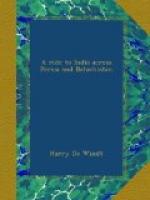Gajjar is a ramshackle, tumble-down place of about three hundred inhabitants. On a small hillock to the right of the village stands the fort, a square building of solid masonry, which, however, is now roofless, and has only three walls standing. The garrison (of six men) were lodged in a flimsy tent pitched in the centre of the ruins. Half the houses were constructed of dried mud; the remainder, as at Gwarjak, of palm leaves. The village stands in a grove of date palms, and the swarms of flies were consequently almost unendurable. We encamped close to the village well, to which, during the afternoon, many of the female population came to draw water. Two of them, bright, pleasant-featured girls of eighteen or twenty, were the best-looking specimens of the Baluch woman that I met with throughout the journey.
Towards sunset the corpse of a young man was borne past my tent and interred in a little cemetery hard by. The burial rites of the Baluchis are very similar to those of Persia. When a death occurs, mourners are sent for, and food is prepared at the deceased’s house for such friends as desire to be present at the reading of prayers for the dead, while “kairats,” or charitable distributions of food, are made for the benefit of the soul of the deceased. A wife, on the decease of her husband, neglects washing, and is supposed to sit lamenting by herself for not less than fifteen days. Long before this, however, her female friends come to her house and beg her to desist from weeping, bringing with them the powder of a plant called “larra.” With this the widow washes her head, and then resumes her former life and occupations. If, however, by thoughtlessness or malice, her friends defer their visit, she must mourn for a much longer period alone. A curious Baluch custom is that of digging a grave much deeper for a woman than a man. They argue that woman is by nature so restless she would not remain quiet, even in death, without a larger proportion of earth over her.
[Illustration: NOMAD BALUCH TENT]
In the matter of births and marriages the Baluchis, being of the Mohammedan religion, regulate their ceremonies mainly according to the Koran. Marriage is attended with great festivities. The first step is the “zang,” or betrothal, which is regarded as of a very sacred nature, the final rite being known as “nikkar.” On the wedding-day the bridegroom, gorgeously arrayed, and mounted on his best horse or camel, proceeds with his friends to a “ziarat,” or shrine, there to implore a blessing, after which the “winnis,” or marriage, is gone through by a moullah. On the birth of a child there is also much feasting. The fourth day after birth a name is given to the infant, and on the sixth an entertainment to friends. The following day the rite of circumcision ("kattam”) is performed, though not always, this being sometimes postponed for a year or more. On this occasion (as at a death) large distributions of food are made to the poor.




